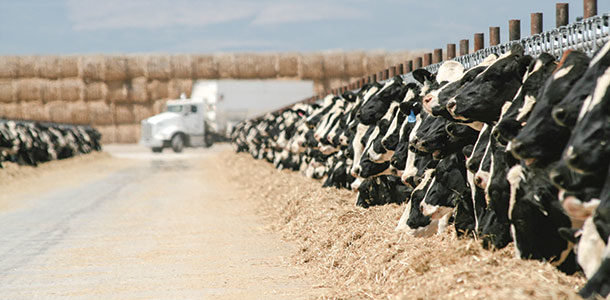The nightmare is over. Many U.S. dairy farms have finally run out of their 2013 corn silage and have begun to feed the 2014 corn silage, and they are seeing much better results with this new harvest. So much so that many farms with 2013 corn silage inventory left have started blending the 2014 corn silage into their feeding programs and are seeing better production and improved components.
Why was the 2013 corn silage so bad? Great growing conditions produced heavy test-weight corn that resisted rumen fermentation.
This lowered volatile fatty production in the rumen (mainly propionate), which decreased energy efficiency and produced fewer rumen bugs. Less-available carbon chains for the bacteria to consume resulted in less microbial protein and poorer total digestion.
This forced nutritionists across the country to feed higher bypass protein rations, add more digestible carbohydrates to the rations and feed higher-energy diets, all at increased cost, to support similar levels of milk production. Not good.
A quick lab comparison between the early 2013 corn silage and the 2014 corn silage findings supports what the cows are telling us. The 2014 corn silage is slightly lower in crude protein, higher in fiber, lower in fiber digestibility and lower in starch content – but also much higher in starch digestibility.
The higher fiber and lower starch contents make logical sense. Most dairymen reported one of the best corn silage yields they have ever had. Taller plants with near-average grain yields resulted in a higher percentage of forage with the starch simply being diluted, resulting in higher fiber with lower starch content.
Many dairymen make the mistake of thinking starch content is the main driver for corn silage quality. If that was the case, why not leave 4 feet of the plant in the field and concentrate the starch even more? No, we harvest corn silage because of its forage tonnage, consistency and high fiber digestibility as well as the starch content.
Look at it this way – 20 pounds of dry matter corn silage contains 8.8 pounds of total neutral detergent fiber (NDF) and 5.3 pounds of digestible NDF but only contains 5.4 pounds of total starch and just 4.6 pounds starch that is rumenally available (at 44 percent NDF, 60 percent neutral detergent fiber digestibility, 27 percent starch at 85 percent in vitro starch digestibility).
These are rough numbers, and the nutrient percentages change, but hopefully this reinforces the point that fiber digestibility is more important in corn silage than the starch content.
With that said, the 2014 corn silage’s fiber is testing a couple of points lower in digestibility. Taller plants need more strength to stand upright. Strength comes from increased lignin content. Higher lignin content means lower fiber digestibility.
The 2013 corn silage ran about 59 percent 30-hour neutral detergent fiber digestibility (NDFd) this time last year, while the 2014 crop is running at 56 percent. So in our number example from above, we have lost about 0.3 pounds of digestible NDF from our 20 pounds corn silage dry matter, or you need to feed a little over a half pound of soyhulls to make that up.
My grandfather had a saying: A dry year will worry you to death, but a wet year can kill you. The 2014 wet, cool growing season certainly helped tonnage but decreased fiber digestibility. The slower digestibility has helped many dairymen see some of the highest butterfats they have seen in some time.
With butterfat’s current high price, this is not an unwelcome guest. I have seen as much as a 0.3 percent jump in butterfat, with most farms seeing a 0.15 percent increase with the 2014 corn silage feeding.
Another reason components and milk are up is the wet, cool growing season certainly lowered test weight and kernel maturity, thus substantially increasing starch fermentability in the rumen.
High rumen fermentability not only increases the energy contribution to the total ration but also drives more microbe production, which increases the microbial protein yield and total ration digestion. (More bugs eat more feed.)
All this should result in cheaper rations on the 2014 corn silage. Most commercial labs are reporting the seven-hour in vitro starch digestion (IVSD) value. In this analysis, the starch ingredient is tested for total starch, put in rumen fluid for seven hours and re-tested for starch again.
The value tells how much of that starch disappeared in seven hours. So a value of 70 percent says 70 percent was digested and 30 percent went undigested after seven hours. Nutritionists use this number to help determine how well the starch will digest in the rumen.
At harvest, there was about a two-point improvement in seven-hour IVSD with the 2014 corn silage, and by December 1 that had increased to a four-point improvement.
The 2013 corn silage started last year in the low 70s and continued there until the late summer or early fall, when it finally started to improve to the mid-70s. In the past, corn silage typically has started in the low 70s but increases to the mid-80s or low 90s by mid-summer.
The 2014 corn silage started in the mid-70s and was in the 80s by early summer, following traditional past patterns. Look for the 2014 high-moisture corns and snaplages to follow a similar pattern.
The lower crude protein content common in the 2014 corn silages also makes sense. Three issues are playing into this. First is the increased tonnage of the corn silage itself. More tonnage spread over the given amount of soil nitrogen means something had to bend.
So if the plant took up its normal nitrogen amount and produced more tonnage with that nitrogen, would that not mean the protein would be more diluted? Hence, crude protein would be lower in the 2014 corn silage.
Second, the constant rain in most of the Midwest could have washed more nitrogen away, reducing the nitrogen available for uptake. Third, there have been more storage losses this year. I have seen more evidence of heavy silo gas production this year than I have in years past.
Silo gas is heavily laden with nitrogen and contributes to reduce the total nitrogen in corn silage. I have also seen more effluent in this year’s corn silage with storage units still seeping months after harvest. This also equals lost nutrients.
The 2014 corn silage will provide both some challenges and opportunities to dairymen and nutritionists. Higher starch digestibility and lower fiber digestibility will change how we feed cows compared to the 2013 corn silage.
Improved milk and components, better feed efficiency, and lowered feed cost will all be welcomed relief in 2014. I think I speak for most of the U.S. dairy industry when I wish the 2013 corn silage good riddance. PD
Photo by PD staff.

Steve Massie
Western Field Nutritionist
Renaissance Nutrition, Inc.






